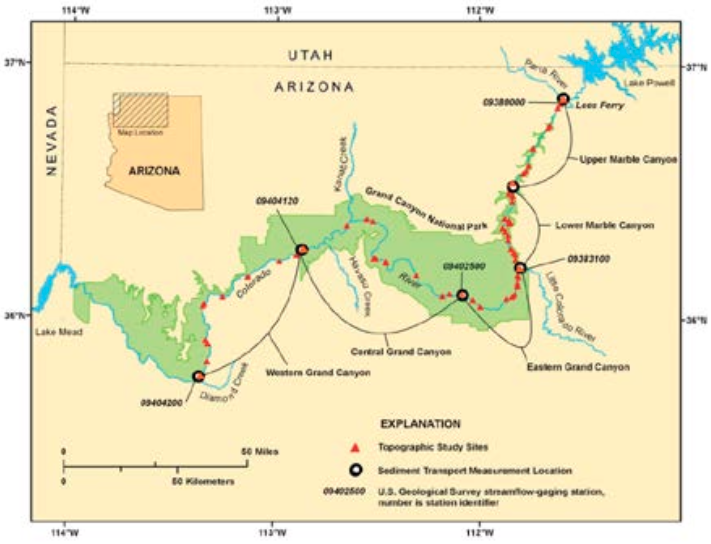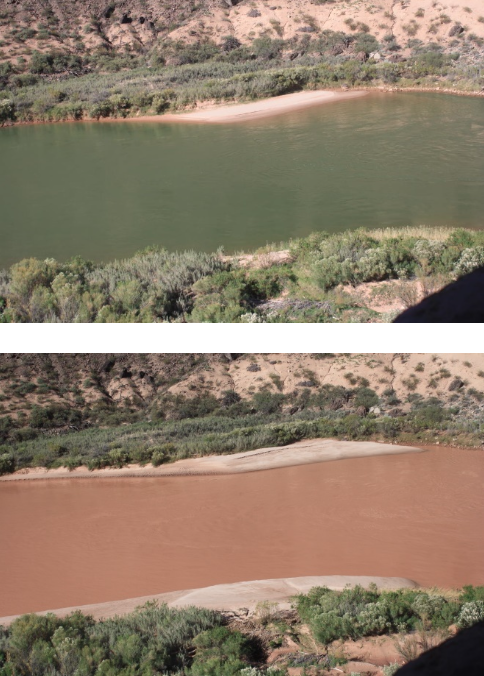The Grand Canyon and the Colorado river that runs through it attract thousands of people every year who wish to enjoy its majestic beauty and recreational opportunities. People are drawn to the canyon every year to fish, raft the river, and view the wonders of the rock formations created so long ago. This tourism brought to the Grand Canyon National Park is incredibly important to the US economy, with a cumulative benefit of $32 billion.
For this tourism industry of the Grand Canyon to thrive, it requires adequate human habitat along the river. Essentially, human habitat signifies that we can easily use the river for our recreation. Rafting is one of the most popular activities on the Colorado River, aside from fishing. Rafting, however, requires navigable rivers, meaning the rapids are not so intense as to threaten safe passage and the sandbars are not built up to such an extent as to impede movement. Additionally, rafters need a place to camp when they are on a week-long trip down in the depths of the canyon. Campsites are primarily sandbars on the edges of the river.
Habitat in jeopardy
However, human habitat is in jeopardy along the Colorado river, reports civil and environmental engineer Jasmin McInerney, and restoring it is a scientific effort. After the Glen Canyon Dam was built in 1966, the natural flow of the river and sediment deposition was drastically changed. Pre-dam, sediment, which is a mix of silt, sand, and organic matter, would travel down the course of the Colorado river and be distributed along the banks via high seasonal water pulses. Now, without the high water flows sandbars on the riverbank erode without being replenished. Additionally, the Glen Canyon Dam traps sediment in Lake Powell and the sediment that is downstream of the dam comes from tributaries. Large rain events wash the sediment from those tributaries into the river channel, building sediment level on the channel floor. The low water flow being released from the dam is not enough to distribute this entering sediment appropriately from the main river channel to the banks. Essentially, due to the altered river flow, the Colorado river is experiencing sediment buildup in the middle of the channel that is not being moved to the banks to create sandbars.
High Flow Experiments: a solution?
In an effort to correct this problem, McInerney explains, scientists and managers have implemented High Flow Experiments. High Flow Experiments are high volume releases of water from the Glen Canyon Dam over a short duration that aim to mimic the seasonal pulses of the original river flow. U.S. Geological Survey has streamflow-gaging stations as well as sediment level measurement instruments along the Colorado river. When they detect that sediment has reached critical levels, they determine the velocity and volume of water flow necessary to obtain the desired results and design a hydrograph based on those determinations. A hydrograph shows the velocity of water flow over time. Water needs to be initially released at high velocity to transport the sediment but later released at low velocity to enable sediment deposition and sandbar creation. Only after these careful considerations are high flows initiated and released.

Fortunately, McInerney says, High Flow Experiments have been shown to be successful in building sandbars. After a HFE in February 2008, average campsite areas at mid elevation zones had an immediate increase of 1200 square meters in April and a lasting increase of 500 square meters in October. High-elevation zones had an immediate increase of 3000 square meters with a lasting increase of 1500 square meters (Hazel 2010). These increases are generally seen as a success in restoring and improving human habitat along the Colorado.

To keep High Flow Experiments successful, however, engineer McInerney emphasizes that scientists need to be able to accurately evaluate results to inform the next experiment to get even better results. Understanding which levels of sediment necessitate action and which hydrograph obtains the best results needs to be carefully studied, as the number of HFEs that can occur are limited by other challenges. For example, Lake Powell needs to have enough water in it to accommodate these flows. In times of drought, HFEs may not be possible, especially when other stakeholders want water for other uses. Additionally, dam and associated hydropower infrastructure have release limitations, meaning they cannot always release the amount at the rate desired in High Flow Experiments.
Policy Recommendations
McInerney recommends several courses of action to overcome these challenges and ensure that human habitat is maintained throughout the Grand Canyon. On an administrative level, maintenance of hydropower turbines that release water from the dam should be planned at times that do not conflict with when we might need High Flow Experiments. McInerney also suggests the possibility of using dams’ emergency spillways for water release, as that might help solve the issue of current dam infrastructure not always able to release large amounts of water. On a scientific level, we need to think of new ways to be ever more efficient in collecting data. Data showing how these experiments are successful helps convince policy makers to continue fund High Flow Experiment monitoring, modelling, further data collection, and analysis. Lastly, McInerney highlights the connection between the goal of maintaining human habitat with other goals of restoring native vegetation and wildlife to the river and riparian ecosystems. High Flow Experiments and the resulting floods and sandbar creation are also necessary for native plant spread and establishment as well creating proper conditions for native fish. Collaboration between scientists of different focuses might ensure the longevity of the HFE program.
